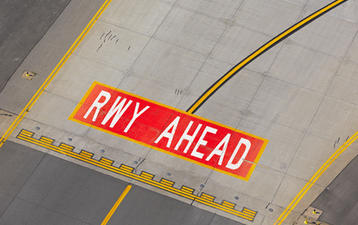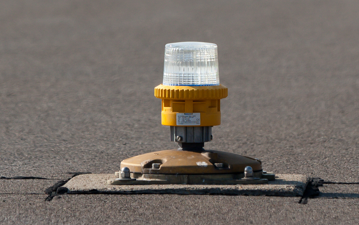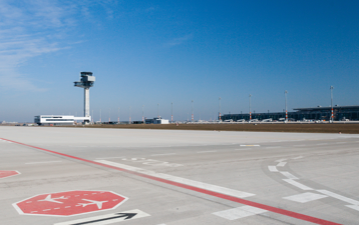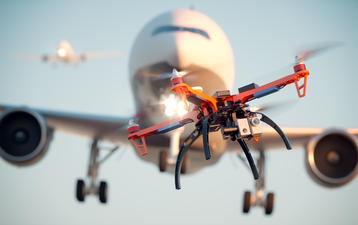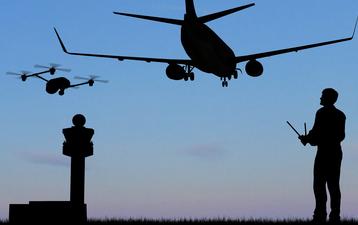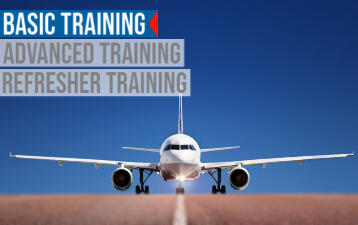Drone Incident Management auf Flugplätzen
*Übersetzung folgt*
Unmanned aircraft systems (UAS), commonly referred to as "drones", are more and more present these days. While being used responsibly, they can be a benefit to society (e.g. during rescue missions), create great video recordings (e.g. TV/film industry) or just be used for hobby-purposes.
However, unauthorised drone operations can become a significant safety hazard when being too close to aerodromes. Besides the evident safety hazard, if a drone is spotted near or at an aerodrome, flight operations are typically suspended or severely interrupted. This results in flight cancellations, major delays and therefore costs to aerodrome operators and airlines. For example, according to EUROCONTROL, a cancelled flight comes at a system-wide average cancellation cost of 18.570 €, while delayed flights can quickly cost more than 100 € per minute.
Being prepared is crucial to mitigate the associated risks as well as to minimise the economic impact. Part of this preparation is the establishment and implementation of a dedicated drone incident management process (e.g. in form of a Standard Operating Procedure) on how to manage drone incidents at the aerodrome. A solid process will save valuable time if operations are suddenly threatened by an unauthorised drone and decisions need to be taken to safely address the incident. Overall, this is somewhat similar to how aerodrome operators already cater for other “conventional” emergency situations. Participants will learn how a process should be structured and which subphases it contains.
This course will make the participants familiar with the key steps which are recommended to be implemented by aerodrome operators and involved stakeholders to cope with potential drone incidents at their aerodromes. Considering best practices, such as EASA guidelines and recommendations, participants will learn how to distinguish between actions that should be taken before, during and after a drone incident. This will ensure that both, proactive as well as reactive measures are implemented at the right stage and level. For instance, during a drone incident, actions should be taken and categorized according to defined phases (e.g. verification, decision, response, restoration phase). The elements of these phases depend on the complexity of the aerodrome. Furthermore, specific reaction teams or task forces could be established to channel the flow of information in case of a drone incident.
After the course, participants will have a better understanding of what drone incident management at their aerodromes means and which essential measures they or their entity can implement. Moreover, it will enable them to incorporate and align the drone incident management with the existing safety management system (SMS) as well as emergency response plans (ERP).
Kursinfo
Ort:BerlinSprache:Englisch
Datum:09.10. - 10.10.2025
Dauer:2 Tage
Anbieter:airsight GmbH
Kursgebühr
Für Kurse in Berlin:
Allen Kunden werden 19% Mehrwertsteuer berechnet.
Der Endpreis wird auf Ihrer Rechnung ausgewiesen.
Hinweis: Wenn Sie mehrere Teilnehmer anmelden wollen, aber einzelne Rechnungen für jeden benötigen, melden Sie bitte jeden Teilnehmer separat an.
Inhalt
*Übersetzung folgt*
Motivation
- Recent cases of drone incidents and their impact
- Business continuity
- Compliance
UAS basics
- Terms and definitions
- Civil drone technology basics
Overview legal framework
- EASA UAS Regulation (EU) 2019/945 and (EU) 2019/947
- EASA operation categories: open, specific, certified
- Protection of ADR surroundings (ADR safeguarding) as required in EASA Basic Regulation (EU) 2018/1139 and (EU) 139/2014
Drone incident management at aerodromes – Phased approach
- EASA and IATA drone incident managment processes
- Roles and responsibilities
- Coordination with ATC and other stakeholders
- Application of risk assessment methodologies to a drone hazard
- Implementation of a dedicated drone incident procedure
- Application of checklists and tools that support drone incident management
- Short introduction to drone detection technology
- Documentation, records and reporting
- Continuous improvement
Referenten
Veronica Schömer, Pilotin Boeing 787, M.Eng.
Veronica ist eine erfahrene Luftfahrtexpertin mit einer besonderen Leidenschaft für das Thema Flugsicherheit. Ihre ersten Schritte in die Luftfahrt machte sie vor über 20 Jahren in einem Segelflugverein. Als Pilotin auf Kurz- und Langstrecke (Boeing 737, 747, 787) hat Veronica mehr als 17 Jahre Erfahrung in der kommerziellen Luftfahrt. Sie hat einen Bachelor-Abschluss in Wirtschaftsingenieurwesen und einen Master-Abschluss in Maschinenbau. Mit ihrer Spezialisierung auf europäische Luftfahrtvorschriften und ihrer Abschlussarbeit über vertrauliche Sicherheitsberichte setzt Veronica sich für Flugsicherheit sowohl in der bemannten als auch der unbemannten Luftfahrt ein. Als Ausbilderin hat sie Studierende der RWTH Aachen in deren Flugsimulator geschult und EDV-Trainingskonzepte für Cockpitbesatzungen entwickelt. Im JARUS Industry Stakeholder Board unterstützt Veronica die erfolgreiche Integration von bemannter und unbemannter Luftfahrt in einem gemeinsamen Luftraum.
Zielgruppe
- Aerodrome safety and operations managers
- Aerodrome security managers
- Aerodrome duty officers
- Aerodrome security and safety personnel
- Civil Aviation Authorities staff
- Air Traffic Control staff
- Governmental organisations and agencies (e.g. police, rescue and firefighting)
Veranstaltungsort
Wir bitten die Teilnehmer, ihre Reise- und Hotelbuchungen selbst vorzunehmen. Für eine Unterbringung empfehlen wir unser Tagungshotel. Weitere Hinweise dazu finden Sie in Ihrer Anmeldebestätigung. Wir möchten darauf hinweisen, dass ab Januar 2025 in Berlin eine Übernachtungssteuer (City Tax) von 7,5% auf beruflich und geschäftlich veranlasste Übernachtungen erhoben wird.
Die Kursgebühr umfasst die Teilnahme am Lehrgang, das Kursmaterial sowie für nicht-virtuelle Kurse die Verpflegung während des Lehrgangs (Kaffeepausen und Business Lunch).
Organisatorische Details
Die Tagungszeiten sind wie folgt gestaffelt:
erster Lehrgangstag: 10.00 - 17.00 Uhr
letzter Lehrgangstag: 8.00 - 16.00 Uhr
Die Verpflegung während des Lehrgangs (Kaffeepausen und Business Lunch) ist in der Kursgebühr enthalten. Nach erfolgreicher Kursteilnahme erhalten alle Teilnehmer ein airsight-Zertifikat nach EASA-Trainingsregularien, welches weltweit in der Luftfahrtbranche anerkannt ist.
Über unsere Lehrgänge
Zertifizierte Qualität
airsight verfügt über ein nach ISO 9001 zertifiziertes Qualitätsmanagementsystem, in dessen Mittelpunkt die Maximierung des Kundennutzens steht. Wir arbeiten ständig an Verbesserungen – so auch bei unseren Lehrgängen, die wir auch anhand des Teilnehmerfeedbacks kontinuierlich optimieren.
Kursinfo
Ort:In-houseSprache:Deutsch / Englisch
Dauer:2 Tage
Anbieter:airsight GmbH
Inhalt
*Übersetzung folgt*
Motivation
- Recent cases of drone incidents and their impact
- Business continuity
- Compliance
UAS basics
- Terms and definitions
- Civil drone technology basics
Overview legal framework
- EASA UAS Regulation (EU) 2019/945 and (EU) 2019/947
- EASA operation categories: open, specific, certified
- Protection of ADR surroundings (ADR safeguarding) as required in EASA Basic Regulation (EU) 2018/1139 and (EU) 139/2014
Drone incident management at aerodromes – Phased approach
- EASA and IATA drone incident managment processes
- Roles and responsibilities
- Coordination with ATC and other stakeholders
- Application of risk assessment methodologies to a drone hazard
- Implementation of a dedicated drone incident procedure
- Application of checklists and tools that support drone incident management
- Short introduction to drone detection technology
- Documentation, records and reporting
- Continuous improvement
Referenten
M.Sc. Moritz Kaschel
Moritz hat einen Master-Abschluss in Luftfahrttechnik und ist darüber hinaus auf Flughafenmanagementsysteme, Auditierung und Flugplatzplanung spezialisiert. Als Mitglied des airsight-Beraterteams ermöglicht ihm diese Kombination von Kompetenzen die Unterstützung von Flugplätzen im Rahmen ihres Zertifizierungsprozesses und in verwandten Bereichen (z.B. Compliance-Checks und Inspektionen, Handbücher und Verfahren, Bodenabfertigungsprozesse).
Bei airsight hat er mehrere Projekte für Flughäfen wie Dublin, Mailand, Luxemburg und andere durchgeführt. Er führte auch Inspektionen der luftseitigen Infrastruktur (einschließlich Beschilderung, Beleuchtung, Markierung) durch, einschließlich der Bewertung des Flugbetriebsflächenzustands – auch unter Einsatz von Drohnen (als Inhaber einer kommerziellen UAV-Betreiberlizenz und eines Sprechfunkzeugnisses).
Kürzlich unterstützte Moritz den Flughafen Luxemburg bei der Erlangung eines neuen Zertifikats gemäß den neuen EASA-Anforderungen - eine mehrmonatige Aufgabe, die eine gute Kenntnis der geltenden Vorschriften sowie Fähigkeiten im Projektmanagement erforderte. Darüber hinaus war er an der Entwicklung eines Plans zur Mängelbehebung für einen großen Flughafen im Nahen Osten beteiligt und führte luftseitige Infrastrukturinspektionen in Westafrika durch.
Aufgrund seiner weitreichenden Erfahrung mit Flughafenmanagementsystemen und der Einhaltung von Vorschriften leitet er mehrere airsight-Lehrgänge.
Veronica Schömer, Pilotin Boeing 787, M.Eng.
Veronica ist eine erfahrene Luftfahrtexpertin mit einer besonderen Leidenschaft für das Thema Flugsicherheit. Ihre ersten Schritte in die Luftfahrt machte sie vor über 20 Jahren in einem Segelflugverein. Als Pilotin auf Kurz- und Langstrecke (Boeing 737, 747, 787) hat Veronica mehr als 17 Jahre Erfahrung in der kommerziellen Luftfahrt. Sie hat einen Bachelor-Abschluss in Wirtschaftsingenieurwesen und einen Master-Abschluss in Maschinenbau. Mit ihrer Spezialisierung auf europäische Luftfahrtvorschriften und ihrer Abschlussarbeit über vertrauliche Sicherheitsberichte setzt Veronica sich für Flugsicherheit sowohl in der bemannten als auch der unbemannten Luftfahrt ein. Als Ausbilderin hat sie Studierende der RWTH Aachen in deren Flugsimulator geschult und EDV-Trainingskonzepte für Cockpitbesatzungen entwickelt. Im JARUS Industry Stakeholder Board unterstützt Veronica die erfolgreiche Integration von bemannter und unbemannter Luftfahrt in einem gemeinsamen Luftraum.
Zielgruppe
- Aerodrome safety and operations managers
- Aerodrome security managers
- Aerodrome duty officers
- Aerodrome security and safety personnel
- Civil Aviation Authorities staff
- Air Traffic Control staff
- Governmental organisations and agencies (e.g. police, rescue and firefighting)
Organisatorische Details
airsight bietet diesen Lehrgang auf Anfrage als In-House-Schulung an.
Nach erfolgreicher Kursteilnahme erhalten alle Teilnehmer ein airsight-Zertifikat nach EASA-Trainingsregularien, welches weltweit in der Luftfahrtbranche anerkannt ist.
Über unsere Lehrgänge
Zertifizierte Qualität
airsight verfügt über ein nach ISO 9001 zertifiziertes Qualitätsmanagementsystem, in dessen Mittelpunkt die Maximierung des Kundennutzens steht. Wir arbeiten ständig an Verbesserungen – so auch bei unseren Lehrgängen, die wir auch anhand des Teilnehmerfeedbacks kontinuierlich optimieren.
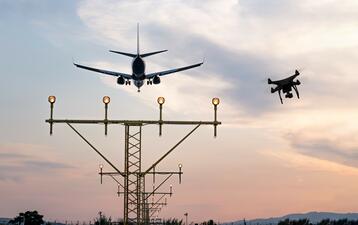
 Sie wollen 5+ Teilnehmer anmelden? Fragen Sie nach einem In-House-Kurs an Ihrem Standort oder online!
Sie wollen 5+ Teilnehmer anmelden? Fragen Sie nach einem In-House-Kurs an Ihrem Standort oder online!
